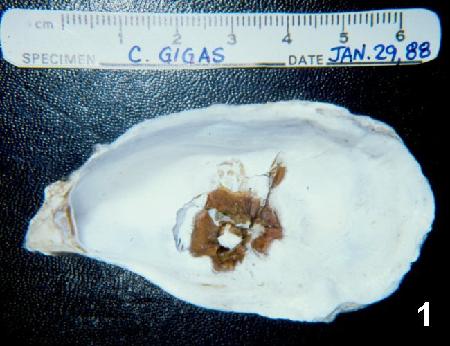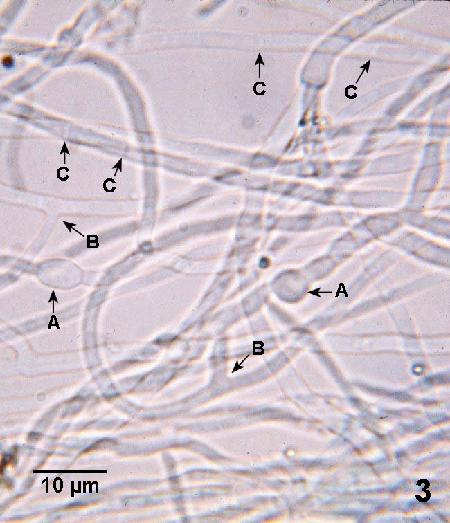Ostracoblabe implexa (Shell Disease) of Oysters
On this page
Category
Category 2 (In Canada and of Regional Concern)
Common, generally accepted names of the organism or disease agent
Shell disease, Dutch shell disease, Maladie du pied, Maladie de la charnière.
Scientific name or taxonomic affiliation
Ostracoblabe implexa. Initially called Myotomus ostrearum.
Geographic distribution
Europe, India, and Canada (both Pacific and Atlantic coasts).
Host species
Ostrea edulis, Crassostrea gigas, Saccostrea cucullata and Crassostrea angulata. The latter species apparently does not produce the severe warts on the shell.
Impact on the host
Grows through the shell, eventually penetrating the inner surface. The disease is limited to the shell, first appearing as small round white spots, which are slightly raised and have a clear centre. These spots coalesce. Conchiolin warts are formed on the inner surface of the shell and can cause severe thickening of the shell margin. If the area beneath the adductor muscle is infected, attachment is weakened and closing of the shell is compromised due to excessive shell production in that area. Distortion can render the oyster unmarketable. Proliferation of the fungus is restricted to waters where temperatures exceed 22°C for more than two weeks, thus shallow beds are more severely affected than deep growing sites.
Diagnostic techniques
Gross Observations
White spots, conchiolin warts, or abnormal shell growth as described above on the inner surface of the shell.

Figure 1. Inner surface of Crassostrea gigas shell valve with a large conchiolin wart caused by Ostracoblabe implexa at the adductor muscle attachment site.

Figure 2. Shell of Crassostrea gigas with abnormal shell growth (arrow) caused by Ostracoblabe implexa at the site of adductor muscle attachment.
Squash Preparations
Microscopic examination of decalcified shell material revealing the presence of a dense mycelial network of straight hyphae 1.5-2.5 µm in diameter. At irregular intervals (40-100 µm) small oval dilations (intercalary swellings) 4-6 µm in diameter occur. Septa only occur on dying mycelia.
Histology
Decalcification of affected shells in 5% solution of disodium diaminoethylenetetraacetate (EDTA) and sectioning to reveal aseptate fungal mycelia. Metaplasia of the mantle epithelium may occur in areas of contact with mycelia which have penetrated the inner shell surface.
Culture
The fungus can be cultured from fragments of deformed shell in sterile seawater containing antibiotics.

Figure 3. Unstained wet mount preparation of Ostracoblabe implexa from a yeast peptone agar culture derived from a deformity on the shell of Crassostrea gigas. Note the intercalary swellings (A), branching hyphae (B) and occurrence of septa at irregular intervals along the hyphae of this 3 day old culture.
Methods of control
Oysters from areas with a record of shell disease (currently or historically) should not be introduced into areas with no history of the disease. Note: Any calcareous substrate can act as a reservoir for this fungus. Temperature is a natural limiting factor. In areas where water temperatures rarely exceed 22°C, development and pathogenicity of shell disease is limited.
References
Alderman, D.J. 1985. Shell disease of oysters. In: C.J. Sindermann (ed.) Fiches d'Identification des Maladies et Parasites des Poissons, Crustacés et Mollusques, No. 16. ICES, Copenhague. 4 pp.
Alderman, D.J. 1986. Fungal diseases of marine invertebrates. European Aquaculture Society, Special Publications 9: 197-201.
Alderman, D.J. and E.B.G. Jones. 1971a. Shell disease of oysters. Fishery Investigations, London (Series 2) 26(8): 1-19.
Alderman, D.J. and E.G.B. Jones. 1971b. Physiological requirements of two marine phycomycetes, Althornia crouchii and Ostracoblabe implexa. Transactions of the British Mycological Society 57: 213-225.
Cole, H.A. and G.D. Waugh. 1956. Shell disease in Portuguese oysters. Nature 178: 422.
Korringa, P. 1951. Investigations on shell disease in the oyster, Ostrea edulis L. Rapports Procès-verbaux Réunion Conseil Permanent International pour l'Exploration de la Mer 128: 50-54.
Li, M.F., R.E. Drinnan, M. Drebot and G. Newkirk. 1983. Studies on shell disease of the European flat oyster Ostrea edulis Linné in Nova Scotia. Journal of Shellfish Research 3: 135-140
Marteil, L. 1976. La conchyliculture française, 2 partie: biologie de l'huitre et de la moule. Chapitre VI: maladies et mortalites. Revue des Travaux de l'Institut des Pêches Maritimes. 40: 285-313. (In French).
Quayle, D.B. 1969. Pacific oyster culture in British Columbia. Bulletin of the Fisheries Research Board of Canada 169: 1-192.
Raghukumar, C. and V. Lande. 1988. Shell disease of rock oyster Crassostrea cucullata. Diseases of Aquatic Organisms 4: 77-81.
Citation Information
Bower, S.M. (2001): Synopsis of Infectious Diseases and Parasites of Commercially Exploited Shellfish: Ostracoblabe implexa (Shell Disease) of Oysters.
Date last revised: June 2001
Comments to Susan Bower
- Date modified: